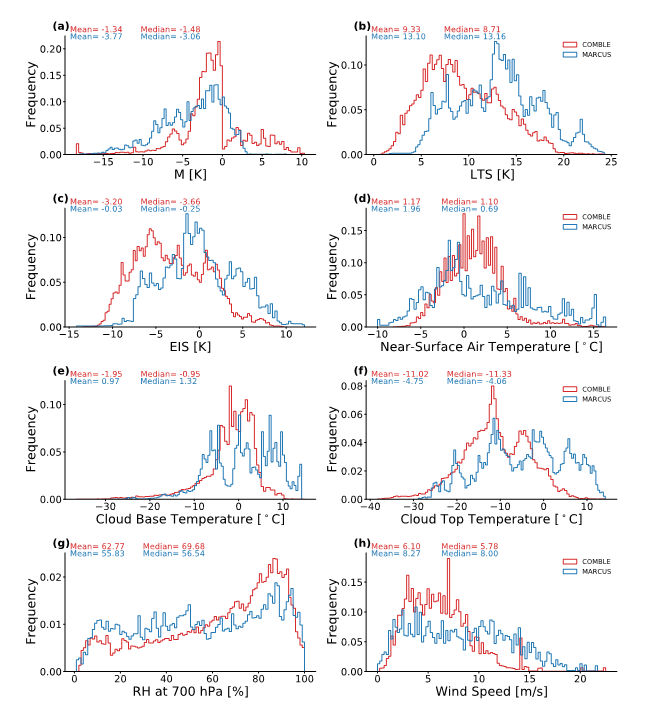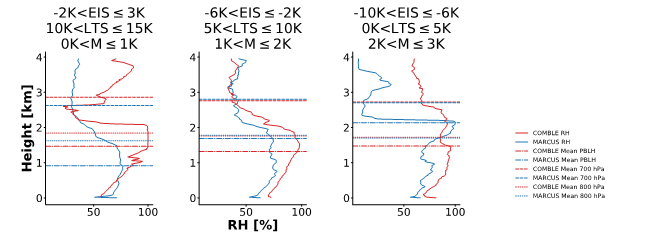Cloud properties vary between the North Atlantic and the Southern Ocean even in similar environments
Submitter
McFarquhar, Greg — University of Oklahoma
Area of Research
Cloud Distributions/Characterizations
Journal Reference
Xia Z and G McFarquhar 2024. "Dependence of Cloud Macrophysical Properties and Phase Distributions on Environmental Conditions over the North Atlantic and Southern Ocean: Results from COMBLE and MARCUS." Journal of Geophysical Research: Atmospheres, 129(12), e2023JD039869, 10.1029/2023JD039869.
Science

Figure 1. Frequency distribution of M index (a), LTS (b), and EIS (c), surface temperature (d), BL cloud base temperature (e), BL cloud top temperature (f), relative humidity (RH) at 700 hPa (g), and surface wind speed (h) over the NA (red) and SO (blue). The averaged and median values of each variable are listed on top of each subplot. Measurements for times with positive M but classified as non-CAOs are not included. Image adapted from Xia and McFarquhar (2024).

Figure 2. Mean relative humidity profiles averaged in different M, LTS, and EIS ranges obtained during COMBLE (red) and MARCUS (blue). Horizontal dash-dotted lines show mean CLT and (below) CBH, dotted line show the mean 800-hPa level, dashed lines show the 700-hPa level, and dash-dotted lines represent the averaged PBLH in each M category. Red (blue) semitransparent envelope represents 25th and 75th percentiles of averaged COMBLE (MARCUS) RH profiles. Image adapted from Xia and McFarquhar (2024).
Cold-air outbreaks (CAOs) occur when cold air moves from the poles over warmer oceans. Extensive boundary-layer clouds form during CAOs, which impacts Earth’s radiative balance. Prior observations of CAO clouds are very limited. Their properties depend on environmental conditions, and the processes responsible for that dependence are not well known, though such knowledge is required for improving their representation in models. The North Atlantic (NA) and Southern Ocean (SO) have large areas of sea ice, providing ideal conditions for the development of frequent and intense CAOs. This study analyzes data collected during two field campaigns conducted over the NA and SO: the 2019-20 Cold-air Outbreaks in the Marine Boundary Layer Experiment (COMBLE) and the 2017-18 Measurements of Aerosol Radiation and Clouds over the Southern Ocean (MARCUS). This research shows that CAOs are more intense over the North Atlantic, whereas the boundary-layer inversion is stronger over the Southern Ocean, and that cloud properties differ over these regions.
Impact
Results from field campaigns over the North Atlantic and Southern Ocean demonstrate that the characteristics of boundary-layer clouds during cold-air outbreaks depend on location even when the environmental conditions are consistent between the two regions. This suggests more field campaigns over both locations are necessary to better identify how cloud properties depend on different environmental conditions in order to provide further insight into the processes that affect cloud evolution.
Summary
This study uses measurements from MARCUS and COMBLE to analyze the correlation between cloud phase, cloud macrophysical properties, boundary-layer vertical structure, and surface fluxes with CAO intensity (M), lower tropospheric stability (LTS), and estimated inversion strength (EIS). This study reveals that BL clouds are common during CAOs in both NA and SO regions, with cloud top heights being higher and boundary layers deeper in more intense CAOs. CAOs sampled over the NA are more intense (larger M), with weaker BL inversion strength (smaller EIS) and lower stability (smaller LTS) compared to the SO. Under the same M, EIS, and LTS conditions, the boundary layer was 12% drier and clouds 46% less turbulent during MARCUS than COMBLE. During CAOs, 54% of single-layer boundary clouds sampled during MARCUS had liquid-dominated bases compared to 39% during COMBLE.
Keep up with the Atmospheric Observer
Updates on ARM news, events, and opportunities delivered to your inbox
ARM User Profile
ARM welcomes users from all institutions and nations. A free ARM user account is needed to access ARM data.


















